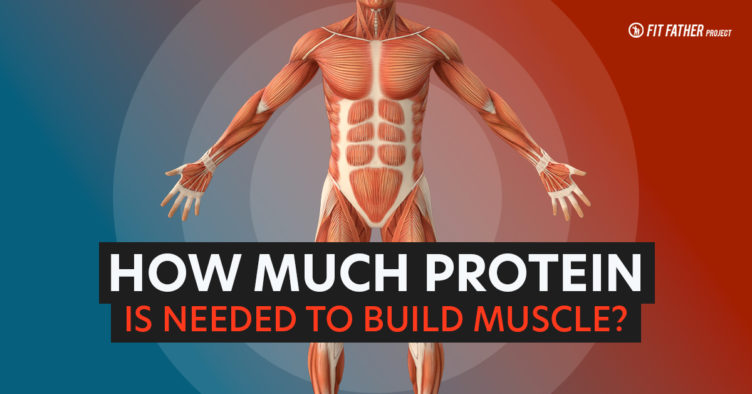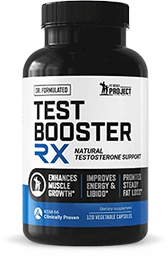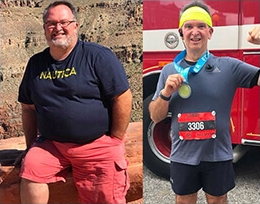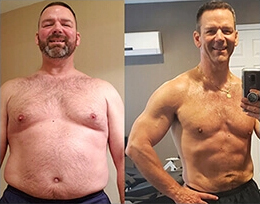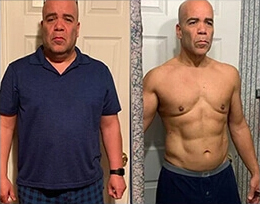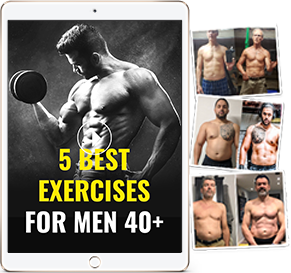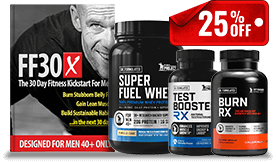When trying to build muscle, you need to be keenly aware of what you're putting in your body, and ‘how much protein to build muscle' is one of the first questions you should be asking.
But protein isn't everything! You need all the right nutrients and a proper muscle-building diet plan!
Beginning a muscle-building diet plan is fairly easy. Start by drinking plenty of water, and slowly increase your overall calorie intake by 350-750 daily.
A few simple tips and tricks to help you increase calories include:
- Consume protein shakes between meals.
- Snack on nuts, seeds, cheese, or dried fruit throughout the day.
- Add extra cheese, nuts, seeds, or avocados to meals and snacks.
- Add protein powder or dried milk powder to shakes, casseroles, soups, and stews.
- Use extra olive oil when cooking.
Remember, an ideal goal is to gain about 1 pound of muscle mass each week until you reach your goal weight.
Remember to get plenty of sleep (7 to 9 hours each night) to keep energy levels high. But perhaps one of the most important components of a muscle-building plan for men is using the right strength training regimen. Maximizing your efforts is vital for muscle growth.
If you're ready to get started and learn how much protein is needed to build muscle, use the easy-to-follow muscle-building diet plan below!
Learn more about how much protein is needed to build muscle and calculate your daily protein intake!
Weight Loss vs Weight Gain Diets
Believe it or not, the main difference between weight loss and weight gain diets is the number of calories you’ll eat throughout the day. For example:
- Weight loss diets contain 500 to 1,000 fewer calories than your usual intake or about 1,500 to 1,800 calories per day for men.
- Weight gain diets consist of eating 350 to 750 additional calories (more than your usual intake) daily to gain about 1 pound of muscle per week, suggests the National Strength and Conditioning Association (NSCA).
- According to the Dietary Guidelines for Americans 2020, active men over 40 often need 2,600 to 2,800 calories daily to maintain their weight. Therefore, a muscle-building diet plan for men over 40 generally consists of eating 3,000 to 3,500 calories daily.
To get in the extra calories needed for muscle mass gains, choose nutrient-dense, higher-calorie foods and eat often throughout the day (every few hours or so).
How Much Protein To Build Muscle and More: Macronutrient Recommendations for Muscle Building
You’ll eat extra calories from protein, carbohydrates, and dietary fat during an effective muscle-building diet plan. These three nutrients are called macronutrients, as they provide calories and energy.
Macronutrient diet recommendations for weight gain are as follows:
Protein Requirements
Following NSCA recommendations for muscle gains, your protein needs when following a muscle-building diet plan are:
- Consume 1.5 to 2.0 grams of protein per kilogram of body weight (0.68 to 0.91 grams of protein per pound of body weight) per day.
- Eat protein frequently throughout the day.
- Consume protein before and immediately after strength training workouts.
Therefore, if you weigh 150 pounds and want to bulk up, aim to eat at least 102 to 137 grams of protein each day.
The protein content of some of your favorite foods, provided by the Academy of Nutrition and Dietetics and the U.S. Department of Agriculture (USDA) Food Composition Database, are:
- 3 ounces of baked chicken (skinless): 26 grams
- 1/3 cup of whey protein powder: 25 grams
- 3 ounces of very lean beef: 24 grams
- 3 ounces of fish (salmon or tuna): 21 grams
- 1 container of nonfat Greek yogurt: 15 grams
- 1/2 cup of low-fat cottage cheese: 14 grams
- 2 large eggs: 12 grams
- 3 ounces of firm tofu: 8 – 10 grams
- 1 cup of cooked green peas: 9 grams
- 1 cup of cooked quinoa: 8 grams
- 1 cup of low-fat milk: 8 grams
- 2 tablespoons of peanut butter: 8 grams
- 1 reduced-fat cheese stick: 6 grams
A good rule of thumb is to consume about 30 to 45 grams of protein at each meal, depending on your daily protein needs, as this amount is associated with muscle mass and strength gains in numerous research studies.
Fill about 1/4th of each plate with non-starchy protein, such as meat, fish, seafood, poultry, eggs, tofu, or reduced-fat cheese.
As a busy guy, it’s challenging to stay consistent with healthy eating. That’s why we created SuperFuel… the delicious “all-in-one” nutrition shake for busy guys 40+ to give your body the protein + key nutrients you need for more energy, fat burning, and muscle building.Meet SuperFuel. The Delicious Protein Shake Packed With 40+ Energy-Boosting Vitamins & Superfoods (Designed For Busy Men)
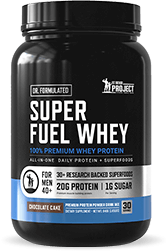
Carbohydrate Needs
You don’t have to worry about following low-carb meal plans when you’re trying to gain lean muscle mass but make sure to choose carbs wisely.
Aim to get about 40 to 55 percent of your daily calories from carbs, or 3 to 5 grams of carbs per kilogram of body weight daily during a strength training program for weight gain, suggests the National Strength and Conditioning Association.
This equates to eating 1.4 to 2.3 grams of carbs per pound of body weight each day. Therefore, if you weigh 150 pounds, aim to consume about 210 to 345 grams of carbs (or more as needed) daily.
Choose healthy, carb-rich foods, such as:
- Whole grains (quinoa, brown rice, wild rice, whole-grain pasta, and oatmeal)
- Fruits
- Vegetables (especially corn, peas, sweet potatoes, dried beans, and other legumes)
- Milk and milk products
- Nuts and seeds
The University of Michigan provides a comprehensive list of the carbohydrate content of some of your favorite foods. Examples include:
- 1 10-ounce baked sweet potato: 60 grams
- 1 cup of cooked rice: 45 grams
- 1 cup of cooked whole-grain pasta: 45 grams
- 1 cup of cooked beans/legumes: 30 grams
- 1 cup of cooked corn: 30 grams
- 1 cup of cooked peas: 30 grams
- 1 cup of cooked oatmeal: 20 grams
- 1 piece of fruit: 15 grams
- 1 cup of milk: 15 grams
Generally speaking, when following a muscle-building diet plan, fill about 1/4th of each plate with starches to meet your daily allotment. About half of each plate should be from vegetables (or veggies plus fruits mixed in).
Dietary Fat Recommendations
Dietary fat is extremely beneficial for a muscle-building weight gain diet. That’s because while protein and carbs each contain 4 calories per gram, fat provides you with 9 calories per gram.
About 20 to 30 percent of your calories should be from dietary fat, suggests NSCA. When eating 3,200 calories a day for weight gain in men, the Dietary Guidelines for Americans 2020 suggest consuming 11 to 12 1-teaspoon portions of healthy fats daily.
Examples of one portion of heart-healthy fats include:
- 1 teaspoon of olive, peanut, soybean, coconut, sunflower, canola, or other plant-based oil
- 1 teaspoon of fish oil
- 1 tablespoon of Italian salad dressing
- 1/3 ounce of seeds
- 1/3 ounce of nuts
- 1 1/2 teaspoons of nut butter
- 8 large olives
- 1/6th of an avocado
Adding nuts, seeds, oils, avocados, and even cheeses to meals and snacks is an excellent way to boost your overall calorie intake as part of a muscle-building diet plan.
Fluid Requirements
Whether you’re trying to lose or gain weight, drinking plenty of water is crucial to keeping energy levels high—especially during workouts. Men often need about 16 cups of fluids daily, sometimes more when participating in regular sweat sessions.
Villanova University recommends the following hydration guidelines for athletes:
- Drink about 2 cups of fluid 2 to 3 hours before workouts
- Consume 1 cup of water right before training
- Drink 1 cup of water every 15 to 20 minutes during training
- Consume a sports drink containing carbs when training longer than 1 hour
- Drink 3 cups of water for every pound of body weight lost during exercise
For the best weight gain results, drink a protein shake before and after workouts to maximize muscle growth.
What About Protein Shakes?
Adding between-meal protein shakes to menu plans is beneficial when you’re following a muscle-building diet plan, especially when drinking shakes before and after workouts. This makes it easier to meet daily protein, carb, and fat needs and keeps your muscles fueled properly so they can grow.
For a total of about 505 calories, mix together:
- 1/3 cup of whey, casein, or other protein powder: 110 calories
- 2 cups of low-fat or plant-based milk: 180 calories
- 1 small piece of fruit or 1 cup of fruit: 80 calories
- 1 1/2 tablespoons of nuts, seeds, or nut butter: 135 calories
- Ice: 0 calories
Total: 505 calories
Change up your protein shake recipes daily, and you’ll never be bored!
As a busy guy, it’s challenging to stay consistent with healthy eating. That’s why we created SuperFuel… the delicious “all-in-one” nutrition shake for busy guys 40+ to give your body the protein + key nutrients you need for more energy, fat burning, and muscle building.Meet SuperFuel. The Delicious Protein Shake Packed With 40+ Energy-Boosting Vitamins & Superfoods (Designed For Busy Men)

Sample Muscle Building Diet Plan
When muscle gain is your goal, many active men over 40 need about 3,000 to 3,200 calories a day in addition to following an effective strength training program, such as Fit Father Project’s Old School Muscle program.
The sample menu below provides about 3,085 calories to achieve muscle-building weight gain. If you need more calories, add extra high-calorie ingredients (extra oils, nuts, seeds, avocado, or cheeses, for example).
Breakfast
- 4 egg (288 calories) omelet with 1/2 cup of sliced green peppers (9 calories), 1/2 ounce of feta cheese (39 calories), and 1/4 cup of sliced avocados (59 calories): 395 calories
- 1 cup of cooked oatmeal: 150 calories
Total: 545 calories
Snack 1
- 1 cup of nonfat Greek yogurt: 175 calories
- 1 ounce of almonds: 165 calories
- 1 cup of sliced bananas: 135 calories
Total: 475 calories
Lunch
- 3 ounces of grilled chicken breast: 130 calories
- 1 cup of cooked asparagus: 40 calories
- 1 cup of cooked quinoa: 220 calories
- 1/4 cup of sliced avocados: 60 calories
- 2 teaspoons of olive oil: 80 calories
- Seasonings of your choice: 0 calories
Total: 530 calories
Snack 2
- Protein shake (see recipe above)
Total: 505 calories
Dinner
- 3 ounces of grilled salmon: 132 calories
- 1 cup of cooked brown rice: 218 calories
- 1 tablespoon of olive or canola oil: 120 calories
- 1 cup of steamed broccoli: 55 calories
- Seasonings of your choice: 0 calories
Total: 525 calories
Snack 3
- Protein shake (see recipe above)
Total: 505 calories
Daily total: 3,085 calories
You can add or subtract ingredients and calories based on your individualized weight gain calorie needs.
Healthy and Protein-Packed Muscle-Building Recipes
Healthy weight gain recipes for muscle building are rich in protein, fiber-rich carbs, and heart-healthy fats. Examples include:
Chicken Spinach
Ingredients:
- 1 boneless chicken breast
- 2 large handfuls of baby spinach or other greens
- 2 strips of bacon or ¼ lb of sausage
- 2 tbsp of sunflower oil
- 2 tbsp of blue cheese
- Portobello mushrooms
Preparation:
- Pour a suitable oil into a large frying pan and heat to a low temperature.
- Slice the mushrooms, chicken, and bacon into bite-sized pieces and place them in the pan.
- Stir the ingredients until the meat is thoroughly cooked, maintaining the lowest possible temperature for cooking.
- Turn the heat off and add the spinach and blue cheese to the pan.
- Gently toss the ingredients and cover for 5 minutes before serving.
This recipe has 300-500 calories and around 50 grams of protein per serving.
Serves 2-4
Protein Frittata
Eggs are among the best and easiest protein foods to add to any muscle-building recipe. A frittata is like an omelet but thicker and fluffier. To make one, whisk up some eggs, throw in some vegetables, and cook the mixture in a pan. Here's a colorful, quick, and easy Italian-style protein-packed frittata.
Ingredients:
- 3 tbsp grass-fed butter or oil of your choice
- 8 eggs
- 2 sliced zucchinis
- ¼ sliced onion
- 1 sliced red bell pepper
- 2 tbsp fresh basil
- Bacon, sausage, or salmon
- 2 tbsp heavy cream, nut milk, or cottage cheese
- Salt and pepper to taste
Preparation:
- Heat a pan over medium-low heat and add the oil, onion, zucchini, and red bell pepper slices. Cook for 5 minutes.
- While the vegetables cook, whisk the eggs and cream in a bowl, making sure to get a lot of air in the mixture to make them fluffy.
- Cook the vegetables for 5 minutes and pour in the egg mixture.
- Turn on the broiler and cook the eggs on the stove-top over low heat for about 10 minutes until almost set.
- Move the frittata to the heated broiler and cook until golden brown.
- Serve with fresh chopped basil.
This recipe has 300-500 calories and 15-20 grams of protein per serving.
Serves 2-4
Roasted Chicken
Roasted chicken is a favorite muscle-building recipe because it's affordable, easy to make, and delicious! Don't get intimidated by the idea of cooking a whole chicken. It's not complicated or difficult, and it will produce far juicier meat. The best part of roasting a whole chicken is using the leftovers in a salad or soup the following day.
Ingredients:
- 1 whole chicken, patted dry
- 2 to 3 tbsp melted butter
- 3 tbsp fresh rosemary or thyme, finely chopped
- 2 medium onions, peeled and quartered
- 5 carrots, peeled and sliced
- 2 lemons, halved
- Salt and pepper to taste
Preparation:
- Preheat the oven to 400 degrees Fahrenheit, and then line a large baking sheet with aluminum foil.
- Combine the butter and 2 tbsp of the rosemary or thyme in a small bowl.
- Rub the chicken with 2/3 of the butter/rosemary mixture and season the chicken with salt and pepper.
- Place the chicken on the baking sheet and surround it with the vegetables and sliced rings from one of the lemons.
- Pour the remaining butter/rosemary mixture over the vegetables and season to taste.
- Place in the oven and cook for 1 hour or until the meat thermometer reads 165 degrees Fahrenheit in the thickest part of the chicken breast.
- Remove from the oven, squeeze lemon juice over the chicken and serve.
This recipe has around 800 calories and 100+ grams of protein per serving (¼ of a 5 lb chicken).
Serves 4-5+
Grilled Steak (or Wild Game) with Tomato-Cilantro Salsa
Steak is the top choice for muscle-building recipes. Choose the best quality steak you can find, preferably locally sourced and grass-fed beef. This recipe works well with T-bones, ribeye, short loin, porterhouse, and wild game cuts.
Ingredients:
- 2-4 cuts of meat
- 4 medium-sized plum tomatoes cut in half
- 3 tbsp olive oil
- 2 garlic cloves, minced
- 1/4 cup fresh cilantro, minced
- 2 tbsp balsamic vinegar
- 4 tsp crushed red pepper (optional)
- Salt and pepper to taste
Preparation:
- Preheat the grill to medium-high heat.
- Drizzle 2 tbsp of olive oil over the sliced tomatoes and season with salt and pepper to taste.
- Place them on the grill and cook until charred and soft, approximately 5 to 6 minutes per side.
- Remove the tomatoes and cool.
- Season the steaks to taste and place them on a cutting board.
- Using two forks, tenderize the meat according to your preference.
- Place on the grill for 3 to 4 minutes per side.
- Remove and let rest for about 5 minutes.
- Chop the roasted tomatoes and throw them in a bowl.
- Mix the cilantro, balsamic vinegar, garlic, crushed red pepper, and remaining olive oil well.
- Top the steaks with the salsa and serve.
Breakfast Protein Shake
Start the day off right with this muscle-building shake for breakfast. It’s commonly recommended that you consume at least 30 grams of protein in the first 30 minutes of the day, so a smoothie of this magnitude is perfect for breakfast. This recipe contains about 40 grams of protein, and that’s without using protein powder!
- 1 cup strong coffee frozen into ice cubes
- 1 banana
- 1 cup almond milk
- 1/3 cup plain or vanilla Greek yogurt
- 1 tablespoon chia seeds
- 1 tablespoon hemp seeds
- Powdered eggs, raw eggs, or protein powder
Blue Berry Spinach Shake
Using frozen produce is a great way to thicken up your smoothies. Bananas and blueberries are one the more delicious combinations for almost any muscle-building smoothie. This recipe is a little sweet for most people, so be generous with the spinach and light on the blueberries.
- ½ cup frozen blueberries
- 1 medium banana
- 2 tablespoons old-fashioned oats/seed of choice
- 1 tablespoon almond butter
- 1 cup unsweetened vanilla almond milk
- 1 date
- 1 handful of spinach
- 1 scoop of protein powder
Peanut Butter and Banana Shake
Peanut butter and banana is a classic combo that cannot go ignored. Fortunately, many new and healthy types of nut butter are on the market now. My local grocer even has a machine that blends fresh nuts into butter, which is amazing because you know there are no unwanted ingredients.
This muscle-building smoothie contains roughly 60 grams of protein per serving. Hemp seeds are a great way to boost your smoothies with high-quality protein and loads of other nutrients. Just be cautious if you start munching on them, as they’re fairly dense with calories. Just two tablespoons of hemp seeds contain over 90 calories!
- 1 banana
- 1 tablespoon unsweetened peanut butter or hazelnut butter
- 2 tablespoons hemp seeds
- 1 scoop of protein powder
- 2 dates
- ¼ teaspoon cinnamon
- 1 cup of almond milk
Veggie Power Shake
This is my personal favorite of the muscle-building smoothies. I love carrots, broccoli, and spinach, so I always have these around the house. They don’t taste that great in a smoothie, so throwing in a banana and some dates is a good idea. Peas are also good if you can tolerate the flavor and texture. Personally, I would rather use pea protein powder than canned peas, but fresh peas taste pretty good if they’re available.
- 6 ice cubes
- ¼ cup baby carrots
- ¼ cup of broccoli florets
- 1 banana
- 1 handful of spinach or kale
- 1 apple
- 1 scoop of protein powder
- 1 date
Mid-Day Refresh Shake
This is a refreshing drink to cool down with. Watermelon or honeydew is also great if you already have some sliced up. Don’t steer away from melon seeds or the peeling of the cucumber/apples. The extra fiber is great for digestion and bowel movements.
Pea protein is a fantastic form of protein that is commonly forgotten about. Mixing up your protein sources to get various protein types is a good idea. This will ensure that your body has all the requirements for rebuilding muscle, tissue, fluids, and hormones for healthy bodily functions.
- 6 ice cubes
- Lime juice
- Lemon juice
- 1 large whole cucumber
- 1 chopped apple
- 1 scoop of pea protein
- 1 cup of watermelon (optional)
Join our 6-Week Program...
You'll Gain Health for Life!In just 6-weeks on our FOUNDATIONS Program, you'll transform your health and body, for the rest of your life!
After watching his own Dad lose his health and pass away at the young age of 42, Dr. Balduzzi founded The Fit Father Project and Fit Mother Project to help busy dads and moms get and stay healthy for their families. Dr. Anthony Balduzzi holds dual degrees in Psychology & Nutrition from the University of Pennsylvania, a Doctorate of Naturopathic Medicine, and is also a former national champion bodybuilder. He’s is most proud of the fact that he’s helped over 40,000 families in over 100 countries lose weight and get healthy for life.![]()
Dr. Anthony Balduzzi, NMD
Men's Health Doctor & Founder
Fit Father Project & Fit Mother ProjectFounder, Fit Father Project & Fit Mother Project
This proven "Old School Muscle Program For Guys 40+" combines the “old school” bodybuilding secrets with the “new school” science… to produce muscle & strength building results fast. Only for guys 40+ who want to build muscle. If you're frustrated with stubborn belly fat, failed diets, and time-consuming workouts, this is the answer you’ve been looking for…Here’s How Busy Guys 40+ Are Building Age-Defying Muscle And Strength… Working Out Just 3 Hours Per Week...
See the Old School Muscle (OSM) Program overview here. You’ll discover how this proven program has helped thousands of guys 40+ pack onage-defying muscle and strength – the smart & sustainable way. »
*Please know that weight loss results and health changes/improvements vary from individual to individual; you may not achieve similar results. Always consult with your doctor before making health decisions. This is not medical advice – simply very well-researched info on how much protein to build muscle.

